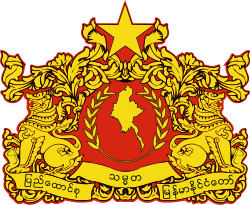Burmese general election, 1925
| | |||||||||||
| |||||||||||
| |||||||||||
 |
| This article is part of a series on the politics and government of Myanmar |
|
|
|
Elections to the Legislative Council were held in Burma on 17 November 1925. [1] Under the terms of the dyarchy constitution, the Legislative Council of Burma was advisory to the British colonial governor, and had some direct authority over education, local government, public health, agriculture and forests.[2] The Nationalist Party received the most votes, but was unable to form a government as the British authorities favoured the Independent Party, who formed a government led by Joseph Maung Gyi.[3]
Electoral system
The Legislative Council had 103 members, of which 80 were elected; 58 "non-communal" seats elected by a common roll, and 24 "communal" seats reserved for ethnic minorities (eight for Indians, five for Karens, one European and one Anglo-Indian) and business groups (two for the Burma Chamber of Commerce, and one each for the Burmese Chamber of Commerce, the Chinese Chamber of Commerce, the Indian Chamber of Commerce, the Rangoon Trades Association and Rangoon University).[4] A further 21 seats were appointed by the Governor (a maximum of 14 of which could be government officials) and there were also two ex officio members, the two members of the Executive Council of the Governor.[4]
Campaign
The Burmese branch of the Swaraj Party led by U Toke Kyi put forward 20 candidates.[5] The Independent Party had 85 candidates, whilst there were 49 Nationalist Party candidates running.[5]
Results
The Swaraj Party performed poorly, with U Toke Kyi defeated in his constituency.[6] Voter turnout was just 16%, although this marked an increase on the turnout of 6.9% in the 1922 elections.[7] This was put down to the success of elected politicians in amending controversial laws during their period in office, as well as an increase in the number of political parties.[7]
| Party | Votes | % | Seats |
|---|---|---|---|
| Nationalist Party | 25 | ||
| Independent Party | 20 | ||
| Home Rule Party | 11 | ||
| Swaraj Party | 9 | ||
| Others | 15 | ||
| Appointed members | 21 | ||
| Ex officio members | 2 | ||
| Total | 103 | ||
| Source: Haruhiro Fukui[8] | |||
References
- ↑ "Burmese Elections. A Forecast", The Times, 18 November 1925, p13, Issue 44122
- ↑ Robert H. Taylor (2009). The State in Myanmar. NUS Press. p. 185. ISBN 978-9971-69-466-1. Retrieved 24 November 2012.
- ↑ Here Today, Gone Tomorrow The Irrawaddy, 3 November 2009
- 1 2 Ganga Singh (1940) Burma Parliamentary Companion, British Burma Press, p38
- 1 2 "Elections In Burma. Grouping Of Parties", The Times, 13 November 1925, p11, Issue 44118
- ↑ "News in Brief", The Times, 25 November 1925, p15, Issue 44128
- 1 2 The Ghost of Elections Past The Irrawaday, 31 May 2010
- ↑ Haruhiro Fukui (1985) Political parties of Asia and the Pacific, Greenwood Press, pp106–154